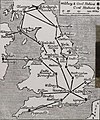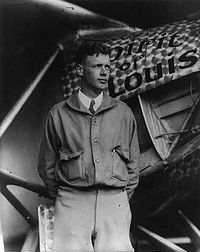Portal:Aviation
| Main page | Categories & Main topics |
|
Tasks and Projects |
The Aviation Portal

Aviation includes the activities surrounding mechanical flight and the aircraft industry. Aircraft includes fixed-wing and rotary-wing types, morphable wings, wing-less lifting bodies, as well as lighter-than-air aircraft such as hot air balloons and airships.
Aviation began in the 18th century with the development of the hot air balloon, an apparatus capable of atmospheric displacement through buoyancy. Some of the most significant advancements in aviation technology came with the controlled gliding flying of Otto Lilienthal in 1896; then a large step in significance came with the construction of the first powered airplane by the Wright brothers in the early 1900s. Since that time, aviation has been technologically revolutionized by the introduction of the jet which permitted a major form of transport throughout the world. (Full article...)
Selected article
Selected image
Did you know
...that Chris Phatswe committed suicide by crashing his Air Botswana plane into two other planes belonging to the airline, effectively crippling operations? ..that Elm Farm Ollie in 1930 became the first cow to be milked while flying in an airplane? ...that during Operation Deep Freeze II in 1956, US Navy Rear Admiral George J. Dufek commanded the first aircraft to land at the South Pole, the C-47 Skytrain “Que Sera Sera”?
General images -
In the news
- May 29: Austrian Airlines cancels Moscow-bound flight after Russia refuses a reroute outside Belarusian airspace
- August 8: Passenger flight crashes upon landing at Calicut airport in India
- June 4: Power firm helicopter strikes cables, crashes near Fairfield, California
- January 29: Former basketball player Kobe Bryant dies in helicopter crash, aged 41
- January 13: Iran admits downing Ukrainian jet, cites 'human error'
- January 10: Fire erupts in parking structure at Sola Airport, Norway
- October 27: US announces restrictions on flying to Cuba
- October 3: World War II era plane crashes in Connecticut, US, killing at least seven
- September 10: Nevada prop plane crash near Las Vegas leaves two dead, three injured
- August 6: French inventor Franky Zapata successfully crosses English Channel on jet-powered hoverboard
Related portals
Associated Wikimedia
The following Wikimedia Foundation sister projects provide more on this subject:
-
Commons
Free media repository -
Wikibooks
Free textbooks and manuals -
Wikidata
Free knowledge base -
Wikinews
Free-content news -
Wikiquote
Collection of quotations -
Wikisource
Free-content library -
Wikiversity
Free learning tools -
Wikivoyage
Free travel guide -
Wiktionary
Dictionary and thesaurus
Selected biography
He grew up in Little Falls, Minnesota. Early on he showed an interest in machinery, especially aircraft. After training as a pilot with the Army Air Service Lindbergh took a job as lead pilot of an airmail route in a DeHavilland DH-4 biplane. He was renowned for delivering the mail under any circumstances.
Lindbergh is recognized in aviation for demonstrating and charting polar air-routes, high altitude flying techniques, and increasing aircraft flying range by decreasing fuel consumption. These innovations are the basis of modern intercontinental air travel.
Selected Aircraft

Aérospatiale-BAC Concorde supersonic transport (SST), along with the Tupolev Tu-144, was one of only two models of supersonic passenger airliners to have seen commercial service.
Concorde had a cruise speed of Mach 2.02 (around 2170 km/h or 1,350 mph) and a maximum cruise altitude of 60,000 feet (18 300 metres) with a delta wing configuration and a reheat-equipped evolution of the engines originally developed for the Avro Vulcan strategic bomber. The engines were built by Rolls-Royce. Concorde was the first civil airliner to be equipped with an analogue fly-by-wire flight control system. Commercial flights, operated by British Airways and Air France, began on January 21, 1976 and ended on October 24, 2003, with the last "retirement" flight on November 26 that year.
Construction of the first two prototypes began in February 1965. Concorde 001 was built by Aerospatiale at Toulouse and Concorde 002 by BAC at Filton, Bristol. Concorde 001 took off for the first test flight from Toulouse on March 2, 1969 and the first supersonic flight followed on October 1. As the flight programme of the first development aircraft progressed, 001 started off on a sales and demonstration tour beginning on September 4, 1971. Concorde 002 followed suit on June 2, 1972 with a sales tour of the Middle and Far East. Concorde 002 made the first visit to the United States in 1973, landing at the new Dallas/Fort Worth International Airport to commemorate its opening.
- Span: 84 ft 0 in (25.6 m).
- Length: 202 ft 4 in[2] (61.66 m)
- Height: 40 ft 0 in (12.2 m )
- Engines: 4× Rolls-Royce/SNECMA Olympus 593 Mk 610 afterburning turbojets 170 kN each.
- Cruising Speed: Mach 2.04 (1,350 mph, 2,170 km/h)
- First Flight: March 2, 1969
- Number built: 20 (including prototypes)
Today in Aviation
- 2012 – a Yemeni Air Force Antonov An-26, a twin-engine turboprop military transport aircraft, crashed in Sana’a, Yemen’s capital, resulting in the deaths of all ten individuals on board, including five military officers.
- 2012 – A ceasefire brings fighting in the Gaza Strip between Israel and Hamas to an end.
- 2012 – JetBlue Flight 1329: An Embraer E190, taxis to its gate after landing at Baltimore-Washington International Airport in Anne Arundel County, Maryland, a fire breaks out in one of its engines. After the airliner reaches its gate, everyone on board evacuates the plane uninjured via the jetway while firefighters douse the fire.
- 2004 – China Eastern Airlines Flight 5210, a Bombardier CRJ200, stalls and crashes near Baotou, China shortly after takeoff because of frost contamination; all 53 on board and two people on the ground are killed.
- 2003 – OH-58D Kiowa 92-0605 from D Troop, 1–17 Cavalry Regiment written off, reason unknown.
- 1990 – First flight of the Hongdu JL-8
- 1989 – A British Airways Boeing 747 narrowly misses crashing into the Penta hotel near Heathrow Airport
- 1986 – The first ever RAF air-to-air refuelling of a fully-loaded passenger carrying transport aircraft. It was carried out on a trooper flight to Oman as part of Exercise Saif Sareea. The refuelling took place over Sicily as part of the 4,200 mile, 9 h flight.
- 1981 – Aeroflot is banned from flying to the United States, after an earlier Aeroflot flight that overflew American military installations, straying from its supposed flight path.
- 1980 – Continental Micronesia Flight 614, a Boeing 727, crashes on landing at Yap International Airport; all on board survive.
- 1970 – US aircraft begin the first major bombing campaign of North Vietnam since 1968. 300 aircraft attack the Mu Gia and Ban Gari passes.
- 1959 – Ariana Afghan Airlines Flight 202, a Douglas DC-4, crashes after an apparent in-flight fire, killing 24 of 27 on board.
- 1958 – Fairey Gannet AS.1, WN345, fitted with Armstrong Siddeley ASMD.8 Double Mamba 112 coupled turboprop powerplant, suffers belly landing this date during test programme, caused by a partially retracted nosewheel. The pilot tries unsuccessfully to get the gear to deploy. Lands gear-up on foam-covered runway 22 at Bitteswell, suffering minimal damage. Repaired, it is back in the air within weeks.
- 1952 – First flight of the Percival Pembroke
- 1948 – The Roundel, the RCAF service publication, made its first appearance.
- 1947 – First flight of the Grumman F9F Panther
- 1917 – 21-24 – The Zeppelin LZ-104 "Das Afrika-Schiff" makes a 6,757 km journey through Africa in 96 hours (average speed 71 km/h).
- 1914 – Three RNAS Avro 504s bomb the Zeppelin sheds at Friedrichshafen.
- 1783 – In a flight lasting 25 min, de Rozier and d'Arlandes take the first untethered ride in a Montgolfière in Paris, the first human passengers carried in free flight by a hot-air balloon.
References
- Shortcuts to this page: Portal:Airplanes • P:AVIA






















































